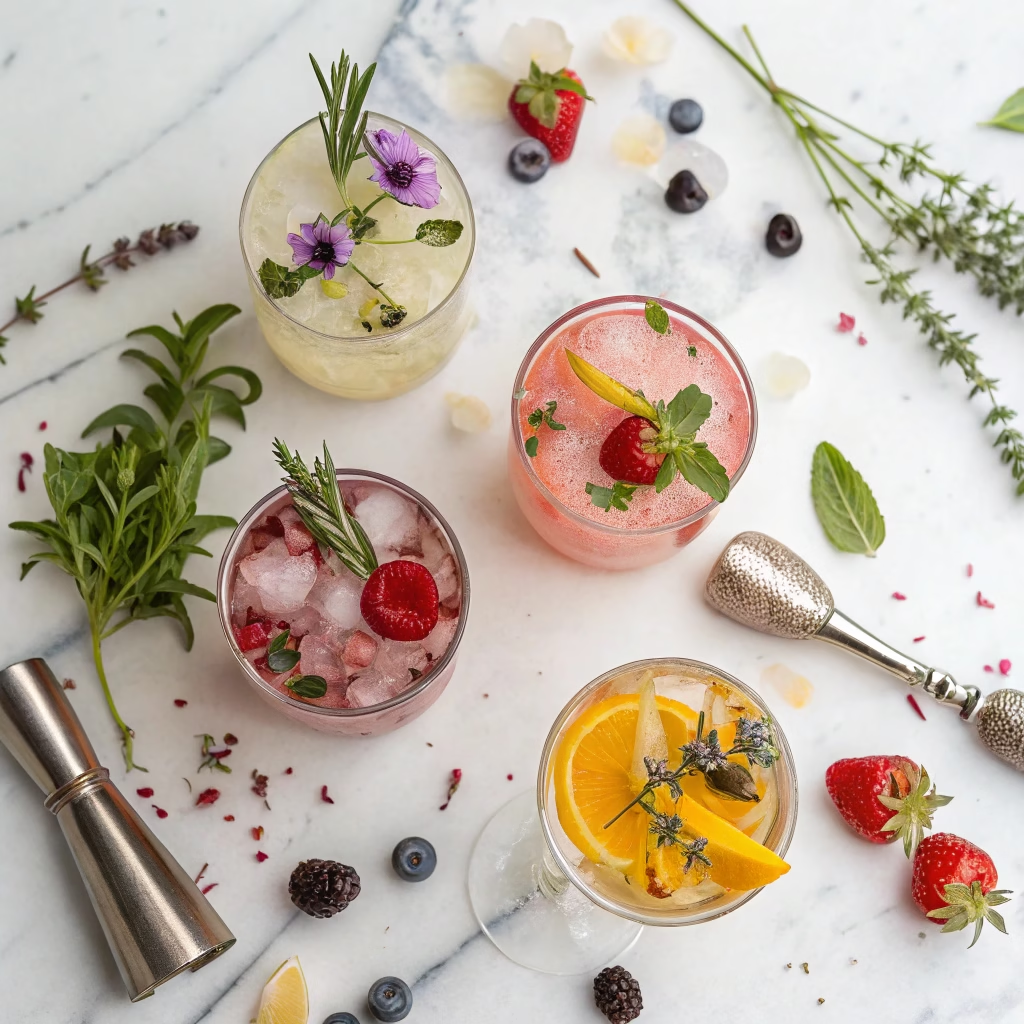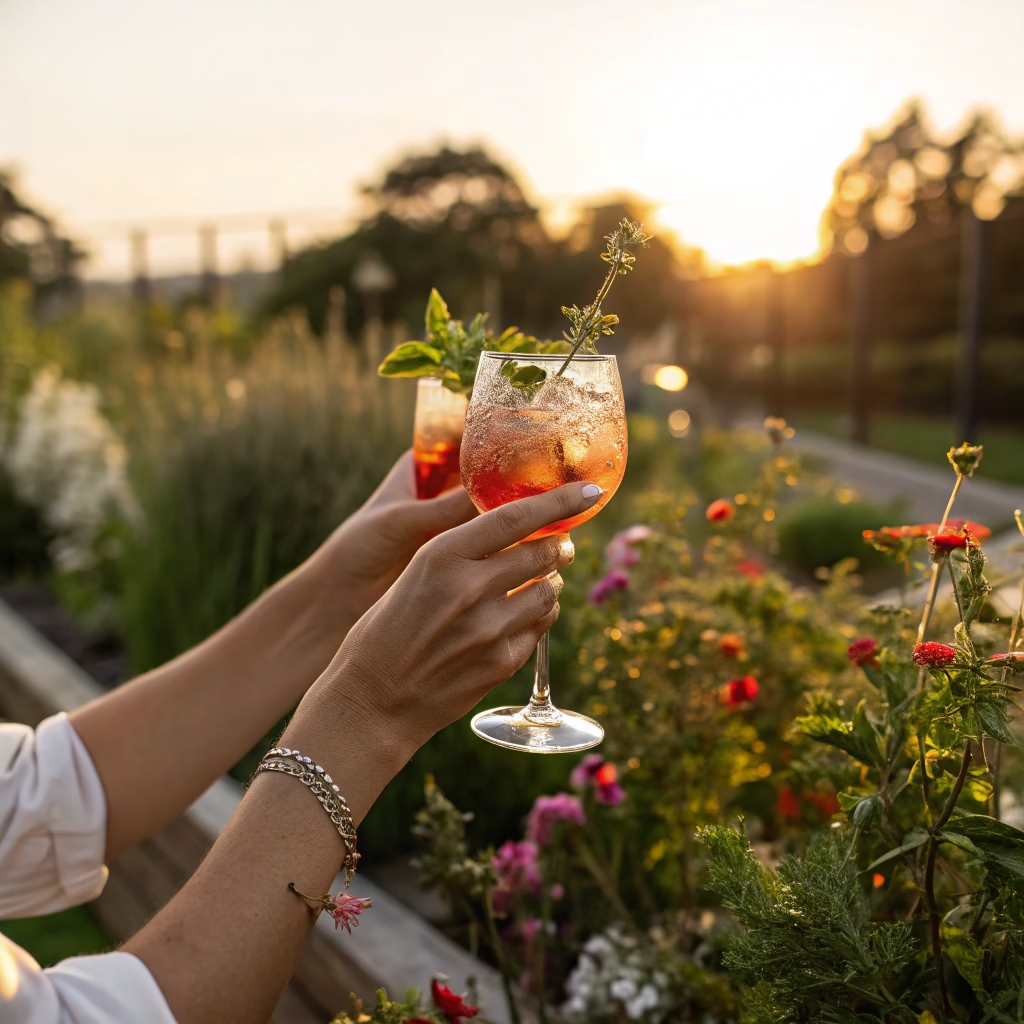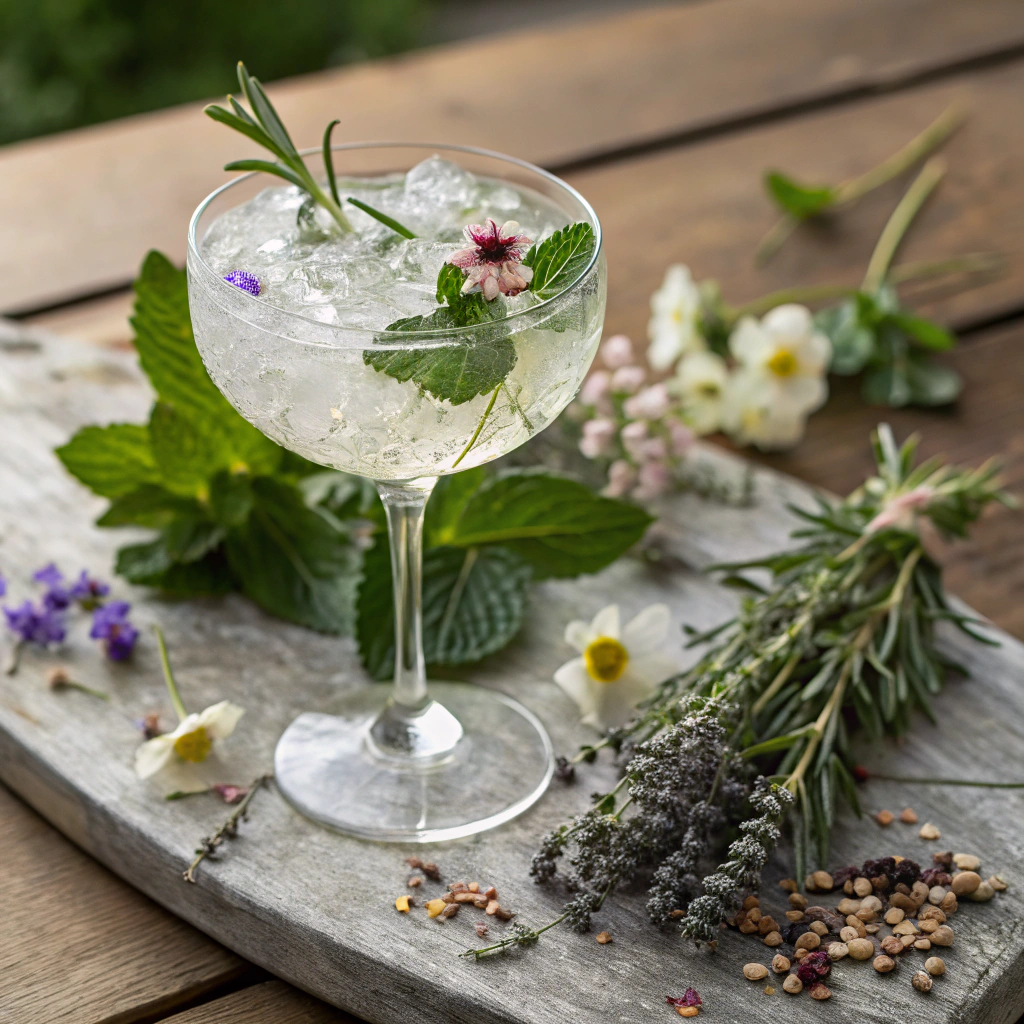Transform your home into a botanical paradise with botanical mocktails that rival the world’s finest establishments – without compromising your health or dietary preferences. These sophisticated botanical mocktails combine the artistry of professional mixology with the pure essence of nature’s finest ingredients.
Most mocktails lack the sophisticated complexity and botanical depth found in premium establishments. They rely on artificial flavors and basic fruit combinations that fail to deliver the nuanced, garden-fresh experience discerning palates crave. The difference lies in understanding how to harness the natural properties of herbs, flowers, and botanical ingredients to create drinks that are both visually stunning and incredibly flavorful.
Master 15 exceptional botanical mocktail recipes plus professional techniques that will transform your home bar into a sophisticated botanical haven. From herb-infused syrups to expert garnishing methods, you’ll learn everything needed to create restaurant-quality drinks that celebrate the natural world’s incredible flavors.
Table of Contents
Essential Botanical Mocktail Ingredients & Their Properties
Creating exceptional botanical mocktails starts with understanding your ingredients. Each botanical element brings unique flavor compounds, aromatic properties, and visual appeal that transforms simple drinks into sophisticated creations.
Fresh vs. Dried Botanicals
Fresh herbs deliver vibrant, immediate flavors perfect for muddling and garnishing. Mint provides cooling menthol notes, basil offers sweet peppery complexity, and rosemary contributes piney sophistication. Fresh botanicals should be used within 3-5 days for optimal potency.
Dried botanicals concentrate flavors and work excellently in syrups and infusions. Dried lavender buds create floral depth without overwhelming delicate drinks, while dried chamomile flowers add honey-like sweetness. Store dried botanicals in airtight containers for up to one year.
Edible Flowers for Mocktails
Safety is paramount when selecting edible flowers. Always source from reputable suppliers or grow your own pesticide-free varieties. For comprehensive guidelines on safe flower selection, consult these edible flower safety guidelines before incorporating any new varieties.
Violets provide subtle sweetness, elderflowers offer muscat-like aromatics, and hibiscus petals contribute tartness with stunning crimson color. Rose petals deliver classic floral notes, while nasturtiums add peppery spice with vibrant orange and yellow hues.
Herb Selection Guide
Mediterranean herbs like thyme, oregano, and sage work beautifully in savory botanical mocktails. Asian herbs such as Thai basil and lemongrass create exotic flavor profiles. Garden classics like cilantro and parsley provide fresh, green notes that complement citrus beautifully.
Consider seasonal availability when planning your botanical mocktail repertoire. Spring offers tender new growth, summer provides peak potency, autumn delivers concentrated flavors, and winter calls for preserved preparations. Many health-conscious consumers are discovering that these wellness-focused mocktails provide both flavor and functional benefits from natural botanical compounds.
Botanical Syrups and Extracts
Creating herb-infused syrups involves gently heating equal parts water and natural sweetener with fresh botanicals. The gentle heat extracts essential oils without destroying delicate compounds. Strain while warm for crystal-clear syrups with intense botanical flavor.
Cold extraction methods work well for delicate flowers like violets or rose petals. Combine botanicals with room temperature simple syrup and allow to infuse for 2-4 hours, stirring occasionally. This method preserves subtle floral notes that heat might diminish.
Equipment & Techniques for Botanical Mocktail Mastery
Professional botanical mocktails require specific tools and techniques that maximize ingredient potential while creating visually stunning presentations.
Essential Bar Tools
A quality muddler with textured end releases herb oils without shredding delicate leaves. Fine-mesh strainers remove herb particles while preserving infused flavors. Jiggers ensure precise measurements crucial for balanced botanical profiles.
Sharp paring knives create clean garnish cuts, while channel knives produce elegant citrus spirals. Quality shakers with tight seals prevent dilution during vigorous mixing. Digital scales provide accuracy when creating botanical syrups by weight rather than volume.
Muddling Techniques
Gentle muddling preserves herb integrity while releasing essential oils. Press herbs against glass bottom with minimal twisting motion. Over-muddling creates bitter, astringent flavors from broken stems and crushed fiber.
Different herbs require varied approaches. Mint responds to light pressure, releasing oils from surface cells. Woody herbs like rosemary need firmer pressure to access deeper oil chambers. Delicate flowers require almost no pressure – simply pressing releases their essences.
For those exploring diverse flavor combinations, techniques used in ginger-infused citrus drinks demonstrate how proper muddling can enhance botanical complexity in unexpected ways.
Infusion Methods
Hot infusions work quickly but require careful temperature control. Heat water to 175-185°F (79-85°C) for most herbs, avoiding boiling which destroys volatile oils. Steep times vary: 3-5 minutes for delicate herbs, 5-8 minutes for woody varieties.
Cold infusions take longer but preserve delicate flavors. Combine botanicals with cool water and refrigerate 2-24 hours depending on desired intensity. This method works exceptionally well for creating clear, bright infusions perfect for elegant presentations.
Professional mixologists often reference proven herbal syrup techniques that ensure consistent results and optimal flavor extraction.
Garnishing Like a Pro
Fresh herb garnishes should be slapped between palms before placement to release aromatic oils. This technique creates an immediate sensory experience as guests approach their drinks.
Floral garnishes require delicate handling. Use tweezers for precise placement, and choose flowers that complement rather than compete with drink flavors. Freeze small flowers in ice cubes for stunning visual impact that slowly releases subtle flavors as ice melts.
15 Signature Botanical Mocktail Recipes
These carefully crafted botanical mocktail recipes showcase diverse flavor profiles and techniques, from beginner-friendly combinations to advanced creations worthy of professional establishments.
Herb-Forward Mocktails
1. Garden Sage Sparkler
– 6-8 fresh sage leaves
– 1 oz fresh lemon juice
– 0.75 oz honey syrup
– 4 oz sparkling water
– Sage sprig and lemon wheel for garnish
Gently muddle sage leaves in shaker. Add lemon juice and honey syrup, shake with ice. Strain into coupe glass, top with sparkling water. Garnish with fresh sage sprig.
2. Rosemary Citrus Refresher
– 2 rosemary sprigs
– 1 oz fresh grapefruit juice
– 0.5 oz fresh lime juice
– 1 oz simple syrup
– 3 oz tonic water
Muddle one rosemary sprig with simple syrup. Add citrus juices, shake with ice. Strain over ice in highball glass, top with tonic. Garnish with remaining rosemary sprig.
3. Thai Basil Lime Cooler
– 8-10 Thai basil leaves
– 1.5 oz fresh lime juice
– 1 oz coconut syrup
– 4 oz cucumber water
– Lime wheel and basil bouquet
Muddle basil gently with coconut syrup. Add lime juice and cucumber water, shake well. Serve over crushed ice with generous garnish.
Floral-Infused Creations
4. Lavender Lemonade Luxury
– 1 oz lavender syrup
– 1.5 oz fresh lemon juice
– 4 oz still water
– Dried lavender buds
– Lemon twist
Combine lavender syrup with lemon juice in shaker with ice. Shake vigorously, strain into ice-filled glass. Top with water, garnish with lavender and lemon twist.
5. Rose Petal Paradise
– 1 oz rose syrup
– 0.75 oz fresh lime juice
– 4 oz lychee sparkling water
– Fresh rose petals
– Crystallized rose petals for garnish
Shake rose syrup and lime juice with ice. Strain into champagne flute, top with lychee water. Float fresh petals, rim glass with crystallized petals.
6. Elderflower Garden Fizz
– 1 oz elderflower cordial
– 0.5 oz fresh lemon juice
– 4 oz prosecco-style sparkling grape juice
– Fresh elderflower sprigs
– Lemon wheel
Gently combine elderflower cordial with lemon juice in flute. Top with sparkling grape juice, garnish with elderflower sprig and lemon wheel.
7. Hibiscus Sunset Sipper
– 1.5 oz hibiscus tea (chilled)
– 1 oz fresh orange juice
– 0.5 oz agave nectar
– 3 oz ginger ale
– Orange wheel and dried hibiscus flowers
Mix hibiscus tea with orange juice and agave. Serve over ice, top with ginger ale. Garnish dramatically with orange wheel and floating hibiscus flowers.

Seasonal Botanical Blends
8. Spring Pea Shoot Spritzer
– 10-12 pea shoots
– 1 oz fresh lime juice
– 0.75 oz simple syrup
– 4 oz cucumber sparkling water
– Pea shoot garnish and lime wheel
Muddle pea shoots gently with simple syrup. Add lime juice, shake with ice. Strain into wine glass filled with ice, top with cucumber water.
9. Summer Cucumber Mint Melody
– 6 inches English cucumber (peeled)
– 8-10 fresh mint leaves
– 1 oz fresh lime juice
– 1 oz honey syrup
– 2 oz coconut water
Muddle cucumber and mint together. Add remaining ingredients, shake well with ice. Double strain into coupe glass, garnish with cucumber ribbon and mint sprig.
These refreshing combinations mirror the complexity found in herbal green tea mojitos, demonstrating how botanical elements can elevate traditional flavor profiles.
Exotic Garden Combinations
10. Lemongrass Ginger Zen
– 2 inches fresh lemongrass stalk
– 0.5 inch fresh ginger
– 1 oz fresh lime juice
– 1 oz palm syrup
– 4 oz coconut sparkling water
Muddle lemongrass and ginger thoroughly. Add lime juice and palm syrup, shake with ice. Strain over ice in rocks glass, top with coconut water.
11. Butterfly Pea Flower Magic
– 1 oz butterfly pea flower tea (chilled)
– 0.75 oz fresh lemon juice
– 1 oz simple syrup
– 3 oz tonic water
– Lemon wheel
Combine tea, lemon juice, and syrup in shaker with ice. Shake well, strain into highball glass with ice. Top with tonic water and watch the color transformation. Garnish with lemon wheel.
12. Cardamom Rose Elixir
– 4-5 green cardamom pods
– 1 oz rose water
– 1 oz fresh lime juice
– 0.75 oz honey syrup
– 3 oz sparkling water
Gently crush cardamom pods in shaker. Add rose water, lime juice, and honey syrup. Shake with ice, double strain into coupe. Top with sparkling water and garnish with rose petals.
13. Fennel Frond Fantasy
– 6-8 fennel fronds
– 1 oz fresh grapefruit juice
– 0.5 oz fresh lime juice
– 1 oz agave nectar
– 4 oz cucumber water
Muddle fennel fronds gently. Add citrus juices and agave, shake well with ice. Strain into wine glass over ice, top with cucumber water.
14. Pine Needle Wilderness
– 1 oz pine needle syrup
– 1 oz fresh lemon juice
– 4 oz sparkling apple cider
– Fresh pine sprig
– Apple wheel
Combine pine syrup with lemon juice in flute. Top with sparkling cider, garnish with pine sprig and apple wheel for forest-fresh aromatics.
15. Violet Leaf Velvet
– 8-10 violet leaves
– 1 oz fresh lime juice
– 0.75 oz maple syrup
– 4 oz elderflower sparkling water
– Candied violets and lime twist
Gently muddle violet leaves with maple syrup. Add lime juice, shake with ice. Strain into coupe, top with elderflower water. Garnish elegantly with candied violets.
Seasonal Botanical Mocktail Guide
Creating exceptional botanical mocktails requires understanding seasonal ingredient availability and how different botanicals perform throughout the year.
Spring Garden Mocktails
Spring brings tender herbs with delicate flavors perfect for light, refreshing drinks. Young mint, early basil, and pea shoots provide bright green notes that celebrate renewal and growth.
Violet season offers brief but spectacular opportunities for floral mocktails. Harvest flowers in early morning when essential oil content peaks. Spring onion flowers provide subtle allium notes for savory botanical combinations.
Summer Herb Coolers
Peak summer delivers maximum potency in Mediterranean herbs. Rosemary, thyme, and oregano reach optimal essential oil concentrations during hot, dry periods. Harvest in morning before heat dissipates volatile compounds.
Summer flowers like elderflower and rose provide intense aromatics perfect for celebratory drinks. Lavender blooms offer concentrated flavor that pairs beautifully with citrus and stone fruits.
Autumn Harvest Drinks
Fall brings woody herbs and late-season flowers with concentrated flavors. Sage develops earthy complexity, while late roses offer deep, wine-like aromatics. Pine needles from new growth provide winter preparation inspiration.
Seed pods and berries add visual interest and unique flavors. Rose hips provide tart, fruity notes, while fennel seeds offer licorice complexity for sophisticated botanical profiles.
Winter Warming Botanicals
Preserved botanicals shine during winter months. Dried herbs maintain potency when properly stored, while frozen flower ice cubes preserve summer’s beauty for cold-weather celebrations.
Evergreen botanicals like pine, fir, and juniper provide warming, resinous notes perfect for holiday entertaining. These ingredients create sophisticated flavors that complement root vegetables and winter spices.
Food Pairing & Serving Suggestions
Maximizing botanical mocktails involves strategic pairing with complementary foods that enhance both beverage and cuisine flavors.
Appetizer Pairings
Herb-forward mocktails complement cheese boards featuring fresh goat cheese, aged cheddar, and herb-crusted varieties. Mint-based drinks pair beautifully with cucumber sandwiches and fresh spring rolls.
Floral mocktails enhance delicate appetizers like stuffed grape leaves, herb-crusted flatbreads, and fresh fruit platters. Rose and elderflower drinks complement Middle Eastern mezze with hummus, tabbouleh, and fresh vegetables.
Main Course Complements
Savory botanical mocktails elevate grilled vegetables, herb-crusted fish, and garden salads. Rosemary and thyme-based drinks complement roasted chicken and lamb dishes beautifully.
Citrus-forward botanical combinations work excellently with seafood, particularly grilled salmon, herb-crusted cod, and Mediterranean fish preparations. The bright acidity cuts through rich preparations while herbs provide aromatic harmony.
Dessert Mocktail Matches
Floral mocktails create perfect endings to elegant meals. Lavender drinks complement shortbread cookies, lemon tarts, and honey-based desserts. Rose mocktails pair beautifully with Turkish delight, baklava, and fruit sorbets.
Herb-infused dessert mocktails work with chocolate preparations and fresh fruit. Mint-based drinks enhance chocolate mousse, while basil combinations complement fresh berry desserts and fruit tarts.
Party Planning Tips
Pre-batch botanical syrups and infusions for large gatherings. Create garnish stations with pre-cut herbs, prepared flower arrangements, and citrus wheels for interactive cocktail experiences.
Consider dietary restrictions when planning botanical mocktail menus. Ensure all ingredients are clearly labeled, particularly for guests with allergies to specific herbs or flowers. Provide multiple options to accommodate varying taste preferences.
Storage & Preservation of Botanical Ingredients
Maintaining ingredient quality ensures consistent botanical mocktail excellence year-round through proper storage and preservation techniques.
Fresh Herb Storage
Store soft herbs like basil, mint, and cilantro with stems in water, covering leaves with loose plastic bags. Change water every 2-3 days to maintain freshness for up to one week.
Woody herbs like rosemary and thyme store well wrapped in slightly damp paper towels inside sealed containers. Refrigerate for up to two weeks, checking regularly for signs of deterioration.
Syrup Shelf Life
Properly prepared botanical syrups last 3-4 weeks refrigerated when stored in sterilized glass containers. Add 1 ounce vodka per cup of syrup to extend shelf life without affecting flavor significantly.
Freeze botanical syrups in ice cube trays for portion control and extended storage. Frozen syrup cubes maintain quality for up to six months, providing year-round access to seasonal flavors.
Freezing Techniques
Freeze herbs in oil using ice cube trays for concentrated flavor preservation. This method works excellently for woody herbs that maintain structure when frozen.
Freeze flower petals individually on parchment-lined trays before transferring to sealed containers. This prevents clumping while preserving visual appeal for garnishing purposes.
Dried Botanical Storage
Store dried herbs and flowers in airtight glass containers away from direct light and heat. Properly dried botanicals maintain potency for 12-18 months when stored correctly.
Understanding proper harvesting timing and storage methods ensures year-round botanical availability. For additional guidance on sustainable practices, reference these comprehensive botanical ingredient harvesting resources.
Frequently Asked Questions
What are the best herbs for botanical mocktails?
Begin with beginner-friendly herbs like mint, basil, and rosemary that offer distinct flavor profiles and forgiving preparation requirements. Mint provides cooling menthol notes perfect for citrus combinations. Basil delivers sweet, peppery complexity that works beautifully with stone fruits. Rosemary contributes piney sophistication ideal for winter botanical mocktails. These herbs readily release essential oils through gentle muddling and pair well with common ingredients, making them perfect starting points for botanical exploration.
How long do botanical mocktail syrups last?
Properly prepared botanical syrups maintain optimal quality for 3-4 weeks when refrigerated in sterilized glass containers. Heat-processed syrups typically last longer than cold-extracted versions due to pasteurization effects. Store syrups in the refrigerator’s main compartment rather than door areas where temperature fluctuations occur. Label containers with preparation dates and strain out all plant material to prevent premature spoilage. For extended storage, freeze syrups in ice cube trays for up to six months without significant quality loss.
Can I make botanical mocktails without special equipment?
Absolutely! Create exceptional botanical mocktails using common kitchen tools with simple modifications. Use a wooden spoon handle for gentle muddling instead of purchasing specialized muddlers. Strain mixtures through fine-mesh kitchen strainers or coffee filters to achieve professional clarity. Mason jars work excellently as shakers when sealed tightly and shaken vigorously. A sharp paring knife creates beautiful garnish cuts, while measuring spoons provide adequate precision for most home preparation needs.
Where can I buy edible flowers for botanical mocktails?
Source edible flowers from specialty grocery stores, farmers markets, and online suppliers specializing in culinary botanicals. Many health food stores carry dried edible flowers in their tea or baking sections. Local farmers markets often feature vendors selling fresh, pesticide-free flowers during growing seasons. Online retailers provide year-round access to both fresh and dried varieties, though shipping costs may be significant for fresh flowers. Always verify suppliers use organic, food-safe growing practices before purchasing.
Are botanical mocktails healthy compared to regular beverages?
Botanical mocktails offer significant health advantages over artificially flavored beverages through natural ingredient benefits. Fresh herbs provide antioxidants, vitamins, and beneficial plant compounds without artificial additives. Many botanicals contribute functional benefits: mint aids digestion, lavender promotes relaxation, and rosemary provides memory-supporting compounds. By controlling sweetener amounts and types, you can create beverages aligned with specific dietary needs. However, monitor total sugar content even from natural sources, and consider any personal allergies to specific botanical ingredients.
How do I grow herbs for botanical mocktails at home?
Start with easy-growing herbs like mint, basil, and chives that thrive in containers and provide quick harvests for botanical mocktail creation. Choose sunny locations with at least 6 hours daily sunlight for optimal essential oil development. Use well-draining potting soil and water consistently without oversaturating roots. Harvest frequently by pinching stems above leaf pairs to encourage continued growth. Indoor herb gardens work excellently near south-facing windows, while outdoor container gardens allow easy movement for optimal growing conditions.

Botanical mocktails represent the perfect fusion of natural ingredients, sophisticated techniques, and creative expression. These garden-fresh creations prove that remarkable beverages don’t require artificial enhancements – nature provides everything needed for extraordinary flavor experiences.
Fresh ingredients make the biggest difference in creating memorable botanical mocktails that rival professional establishments. By understanding seasonal availability, proper storage methods, and extraction techniques, you’ll consistently create drinks that celebrate the natural world’s incredible diversity. Practice and experimentation lead to mastery, so start with familiar herbs and gradually explore more exotic botanical combinations.
Begin your botanical mocktail journey today by trying the Garden Sage Sparkler recipe, and share your creative variations with fellow enthusiasts. The world of botanical beverages offers endless possibilities for those willing to explore nature’s remarkable flavor palette.
Botanical Grapefruit Mocktail
Elevate your mocktail game with this absolutely exquisite Botanical Grapefruit Rose Mocktail that’s like sipping liquid poetry! This sophisticated drink features a carefully crafted 48-hour infusion of pink grapefruit, aromatic herbs, and delicate botanicals including Pakistan rose petals, juniper berries, and French tarragon. The result is a complex, layered flavor profile that rivals the finest craft cocktails—floral, citrusy, and utterly enchanting. Perfect for special occasions, garden parties, or when you want to impress with something truly unique. This is mocktail artistry at its finest!
- Prep Time: 15 minutes
- Cook Time: 0 minutes
- Total Time: 15 minutes (plus 24-48 hours infusion)
- Yield: 1 mocktail (infusion makes 8-10 servings) 1x
- Category: Beverage
- Method: Infusion
- Cuisine: Artisan Botanical
- Diet: Vegan
Ingredients
For the Botanical Infusion (makes multiple servings):
- Zest of 1 pink grapefruit
- Zest of 1 lemon
- ½ cup fresh-squeezed pink grapefruit juice
- ⅛ cup fresh-squeezed lemon juice
- 2 pieces lemongrass (2-inch pieces), bruised and cut into thirds
- 4 teaspoons Pakistan rose petals
- 2 teaspoons juniper berries
- 2 teaspoons French tarragon
For Each Mocktail:
- 1 fl oz strained botanical infusion
- 3 fl oz sparkling water, chilled
- Ice cubes (optional)
For Elegant Garnish:
- Grapefruit or lemon twists
- Additional rose petals (optional)
- Fresh tarragon sprig (optional)
Instructions
- Create Your Botanical Masterpiece: In an airtight glass jar, combine grapefruit zest, lemon zest, fresh grapefruit juice, lemon juice, bruised lemongrass pieces, Pakistan rose petals, juniper berries, and French tarragon. Stir gently to ensure all botanicals are completely submerged in the citrus juices.
- Patience Creates Perfection: Seal the jar tightly and refrigerate for 24-48 hours. The longer infusion time allows the delicate botanicals to release their essential oils and create that complex, layered flavor profile that makes this drink extraordinary.
- Strain to Clarity: When ready to serve, strain the infusion through a fine-mesh sieve, pressing gently on the solids to extract maximum flavor. Your beautiful, aromatic infusion will keep in the refrigerator for up to 7 days!
- Build Your Sophisticated Mocktail: In a beautiful serving glass, combine 1 fl oz of the strained botanical infusion with 3 fl oz of chilled sparkling water. The bubbles will enhance the aromatic qualities and create a refreshing effervescence.
- Add Ice and Elegance: Add ice cubes if desired for extra chill, then garnish with a expertly twisted grapefruit or lemon peel. For extra sophistication, float a few rose petals or add a sprig of fresh tarragon.
- Serve with Ceremony: Present this artisan creation immediately and encourage guests to smell the aromatic bouquet before sipping. This is a drink to be savored slowly and mindfully!
Notes
This is mocktail artistry that requires patience but delivers extraordinary results! The 48-hour infusion is crucial for developing the complex botanical flavors—don’t rush this step. Pakistan rose petals and French tarragon can be found at specialty spice shops or ordered online, and they’re worth seeking out for authentic flavor. Juniper berries add a subtle gin-like complexity without any alcohol. The infusion concentrate makes multiple drinks, perfect for entertaining. For best results, use organic citrus and bruise the lemongrass properly to release its aromatic oils. This sophisticated mocktail is naturally vegan and gluten-free.
Nutrition
- Serving Size: 1 mocktail (4 oz)
- Calories: 15
- Sugar: 3g
- Sodium: 5mg
- Fat: 0g
- Saturated Fat: 0g
- Unsaturated Fat: 0g
- Trans Fat: 0g
- Carbohydrates: 4g
- Fiber: 0.2g
- Protein: 0.2g
- Cholesterol: 0mg


